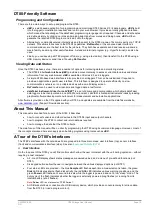
UM-0085-B09
DT80 Range User Manual
Page 32
RG
Variations
To simplify parsing by host applications, the CSV format files generated by the DT80 are essentially fixed format.
However the following parameters may be used to vary the format:
•
P38
can be used to change the character used as the decimal point. By default, this is set to 46, which is the
ASCII code for a period character (.). For European applications, it is often set to 44, which is the code for
comma (,). If this is set to comma then the data separator is automatically changed to semi-colon (;).
•
P41
can be used to change the number of decimal places shown for timestamp values (default 3).
For example, setting
P38=44 P41=0
would result in:
"Timestamp";"TZ";"Ext Temp (degC)";"2V (mV)";"1CV";"B.ALnum";"B.ALstate";"B.ALtext"
2010/03/01 09:54:38;n;22,896844;-0,05822
2010/03/01 09:54:39;n;22,894454;-0,058563
2010/03/01 09:54:40;n;22,899576;-0,057869
2010/03/01 09:54:41;n;22,897856;-0,056656
2010/03/01 09:54:42;n;22,893504;-0,05735
2010/03/01 09:54:38;n;;;3
2010/03/01 09:54:40;n;;;4
2010/03/01 09:54:42;n;;;1
2010/03/01 09:54:40;n;;;;2;1;"trig 22.9"
Data in this format can then be readily imported into spreadsheet applications which are set up for a European locale.
Error Values
In the event of an erroneous sample value, e.g. analog input overrange, or calculation error, a textual error string will be
inserted into the CSV data in place of the data value, e.g.
2010/03/01 09:54:40.000,n,OverRange,-0.057869
When this is imported into a spreadsheet application, the non-numeric data value will typically plot as zero.
Native (DBD) Format Data
When the DT80 logs data to its internal memory, it stores it in fixed size data files, one for each schedule. These files
have a .DBD file extension, e.g.
DATA_A.DBD
.
An alternative way of getting data out of a DT80 is to transfer relevant .DBD files to the host computer. These files can
then be opened using tools such as:
•
dataTaker dump_dbd (which can convert to CSV format). This utility is available on the dataTaker resource CD
or on the datataker.com website.
•
third party packages such as DPlot, which provides plotting facilities.
For large data files, it is often significantly faster to transfer data in DBD format, as the DT80 does not need to perform
any data conversion and formatting.
Native format DT80 data files can be saved to files on the DT80 internal file system, a USB memory device or an FTP
server. As with CSV format output, this is done using the
COPYD
command; the only difference being that a
format=dbd
option is specified.
For more details, see
.
Fixed Format Data
Logged data may also be unloaded to a file as fixed format records, as described in
. This is
primarily intended for use with legacy host applications such as DeLogger.
To retrieve data in fixed format, use
COPYD format=fixed
.
Free Format Data
Data may also be unloaded in traditional dataTaker "free format" mode, as described in
. This
format may be customised using a number of parameter and switch settings.
To retrieve data in fixed format, use
COPYD format=free
.
















































